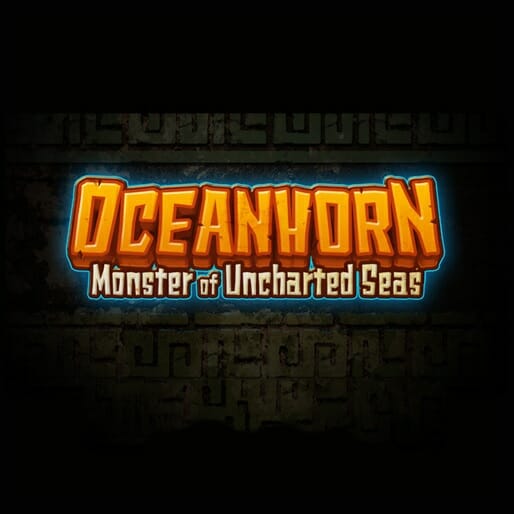
The desire to play Nintendo games on your iPhone has been a fanboy fantasy for years now. It’s resulted in tens of thousands of jailbroken iPhones, the purchasing of Android and even desperate cries for Nintendo to become a third party developer. While the idea of Nintendo putting Mario or Zelda on your iPhone might never actually happen, Oceanhorn: Monster of Uncharted Seas just might be the next best thing.
That being said, there’s no doubt that Oceanhorn has been released at a particularly unfortunate time. Not only was the Legend of Zelda: Link Between Worlds just released for the 3DS, but so was the HD remake of the Wind Waker on the Wii U—both to the joy of critics and fans alike. Zelda is on everyone’s minds right now, making a Zelda clone feel pretty much unnecessary at this point. There is just plenty of Zelda to go around right now as is.
As if you couldn’t tell from the screenshots and video that’s out there, Oceanhorn isn’t shy about its influences—most of its gameplay, setting and thematic elements are all borrowed straight out of the 2002 GameCube hit The Legend of Zelda: Wind Waker. The graphics are bright and cartoony and the protagonist has spiky hair and a sword/shield combo. It even consists of a series of islands that must be traversed between by boat. While that alone precludes the game from being anything revolutionary, it doesn’t mean Oceanhorn isn’t worth your time. After all, unlike other big iOS showstoppers like Modern Combat, N.O.V.A or Shadowgun, the end product here feels like it was made ground-up for iOS.
Oceanhorn is played in a top-down, isometric camera view, which feels great for a Zelda-like game—the action feels close, but without any of complications of controlling a behind-the-back 3D action/adventure that might drag down a touch-only game. The implementation of the invisible joystick feels surprisingly seamless, as does the one do-all on-screen action button. You’ll run into occasional problems where you pick up a pot instead of swing your sword or can’t see certain parts of the environment because of the static camera, but it’s pretty forgivable in the bigger picture. Overall, playing Oceanhorn makes you appreciate how much care the developers put into translating console control concepts into the touchscreen world.
Oceanhorn starts out how many Zelda games start: An orphaned child who needs to find a way out of his hometown to get out and explore the wider world. In Oceanhorn, your protagonist sets out to follow in the footsteps of his father, who went to seek out the destruction of the titular ocean monster. Within five or ten minutes, you’ll get your first real weapon, hop on your boat and start sailing the seas in search of adventure. Everything from the combat to the plot devices to the sailing feels like Wind Waker-lite, which is totally appropriate for a small screen translation. But the borrowed elements aren’t where Oceanhorn falls short—it’s the new stuff that is brought into the mix that feels sloppy or inconsequential.
New islands are only able to be discovered when they are mentioned in dialogue by an NPC, which is fine—except that you’ll sometimes travel to a new island only to find that the only point of the island is to find a particular NPC that will tell you about another island so you can get to the real stuff that matters. Buildups to finding the actual dungeons on these islands also feel very unbalanced compared to the depth of the dungeons themselves, while some of the islands that you thought were going to be important consist of nothing more than some random exploration with little to no climax or payoff.
Speaking of getting to that “real stuff that matters”, Oceanhorn just doesn’t offer nearly the same amount of wit and interesting level design that makes Nintendo games so great. The level design in Oceanhorn isn’t on the same level as the game’s great visuals and soundtrack—it too often reverts to overly familiar Zelda logic. Puzzles are overly simple, the layout of environments is unnecessarily complicated and the combat quickly grows repetitive. Throughout Oceanhorn, you’ll find these odd pacing elements that just don’t feel like polished game design—again, in stark contrast to the game’s high production values.
And yet as odd as it may sound to say, the success of a game like Oceanhorn doesn’t rely completely on these core gameplay elements—it still has enough charm to interest me in finishing the ambitious, 15 hour adventure without complaining. It’s impressive enough a feat to be worth the $12.99 and some late-night play sessions—especially if you’re a Zelda fan.
However, we still aren’t quite there from a game design perspective. Oceanhorn wouldn’t be innovative or unique enough to make it on any other platform. It’s easy to recommend as an iOS game, but it’s hard to recommend as a game in itself, especially when two other fantastic Zelda games came out this year (not to mention the series’ incredible legacy of games). But if you’ve finished those and are still thirsty for more, Oceanhorn might be enough to tide you over until we get an official follow-up to Twilight Princess on the Wii U.
Here’s to hoping that Oceanhorn inspires the development of the next big iOS franchise that is actually as good as Zelda or Mario or Halo or Spelunky or Mario Kart or Braid. If nothing else, Oceanhorn proves that it is certainly possible.
Oceanhorn: Monster of Uncharted Seas was developed by Cornfox & Bros. and published by FDG Entertainment. It’s available for iOS devices.
Luke Larsen is the tech editor at Paste Magazine. You can follow him on Twitter at @lalarsen11.
